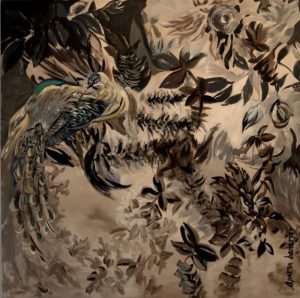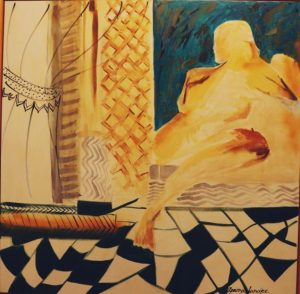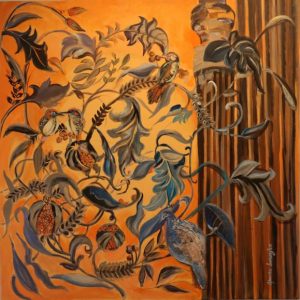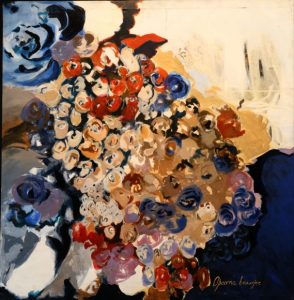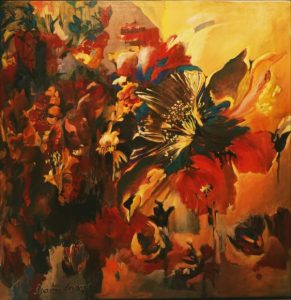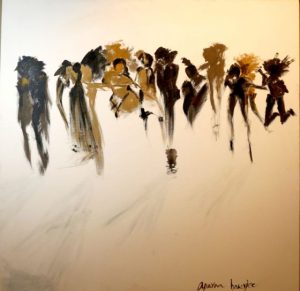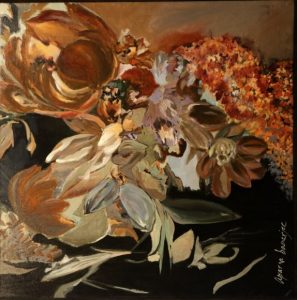‘The Sacred Wild’ is a travelogue on canvas
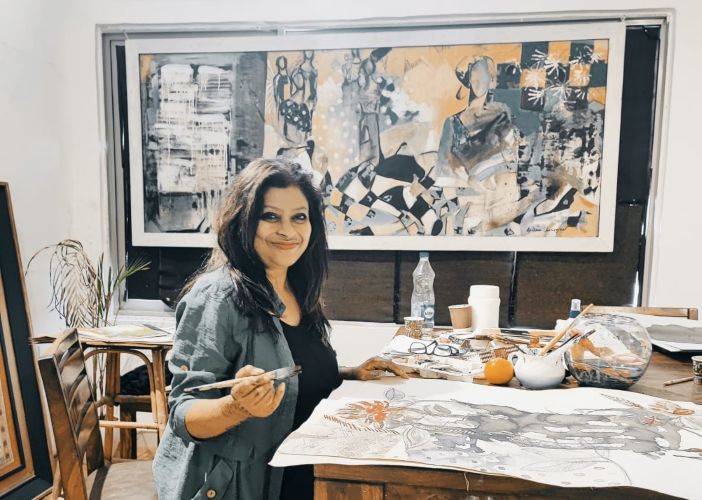
Artist Aparna Banerjee at work
Rajkumari Sharma Tankha
A self taught visual artist, Aparna Banerjee, grew up in a Bengali family which encouraged artistic and intellectual conversations. She took to expressing art at an early age as a necessary and healthy escape from routine life. Today, she is an acclaimed artist of international repute and has represented India at numerous art platforms and summits abroad. Presently on at Bikaner House, Pandara Road in New Delhi, The Sacred Wild is her 75th exhibition. Excerpts from an interview:
Please tell us more about your show The Sacred Wild. How many total works are there and how long did you take to complete these?
After my last exhibitions — An Intimate Affair at Bikaner House, centered on women empowerment, and Framing Flowers, which drew from my experiences in Kenya, its vibrant floral markets, the Maasai community, and the innocence of African children — I return to Bikaner House after two years with The Sacred Wild.
This new body of work emerges from my travels across the length and breadth of India, especially along the ancient Silk Route. The works also reflect the architectural marvels of Tamil Nadu’s temples and mansions to which I travelled . These journeys left me deeply moved by their sense of continuity, the way stone, carving, and memory embody endurance and grace.
Closer to home, in Gurgaon, I find inspiration in the rhythm of everyday nature. The peahens that wander near my garden, the blooming of lotus, aparajita, madhabilata, harshringar, and wild ferns all impact me. These forms, both sacred and familiar, have found their way into my canvases.
The exhibition presents around 30–35 works in varying sizes — from 4×5 ft canvases to more intimate 2×2 ft pieces — created over the past two years. I’ve worked primarily in acrylics on canvas and watercolours on acid-free paper, balancing the strength of structure with the fluidity of nature.
What is the idea behind holding this show? What are your expectations?
The Sacred Wild is born out of a deep reflection on memory, women’s resilience, and our living heritage. Over time, I’ve come to see nature, architecture, and the feminine spirit as inseparable. Each carries layers of endurance, grace, and silent strength. Through this body of work, I’ve tried to ground those ideas in the tangible world around me — temple gateways, sacred flora, and the quiet, instinctive life of animals and birds that surround us.
The show is a meditation on continuity — how life, architecture, and womanhood carry within them a sacred wildness that resists erasure. My expectation is simple yet meaningful: I hope viewers slow down, look closely, and find a bit of their own history and emotion reflected in these works. If they walk away feeling more connected — to their roots, to nature, and to themselves — the exhibition will have served its purpose.
Do you think a formal education in art helps? Or is it an innate quality?
Just as writing requires a command over words and expressions, art too benefits from formal education — it provides a foundation, discipline, and technical understanding. However, what truly defines an artist cannot be taught in a classroom. Expression, observation, and sensitivity are either inborn or slowly nurtured through years of dedication, reflection, and an unending thirst for knowledge.
For me, creating art has never been just about painting a beautiful picture to complement a space. It’s about intellectual and emotional growth — a conscious act to make people pause, think, and engage. Art must encourage us to savour and conserve nature, respect our heritage, and acknowledge the silent strength of women who, across generations, have held families and communities together. Their silence is not weakness — it is resilience, grit, and grace.
What draws you to painting, and not other art forms?
Painting, to me, is a conversation with myself. It’s about asking questions, engaging with thoughts, and admiring different perspectives. When a work intrigues people or makes them pause, I know I’m moving in the right direction — that my inner dialogue is resonating outward.
I’m drawn to painting because of its immediacy and the joy of colour. It’s a language that both children and adults instinctively respond to — simple, direct, and full of emotion. Through colour and form, I find a way to translate what words often cannot express.
Which medium do you like and excel in, and why?
I love working with paper — it has a soul of its own. My attachment to it goes back to childhood, when my father would bring home printed waste paper for me to draw and paint on. He would bind the sheets neatly and hand them to me with care. Wastage was never an option, and perhaps that early lesson shaped my sensitivity toward materials and the value of every surface I work on.
Over the years, paper has remained my most intimate space. I enjoy creating collages and mixed-media works on it — it allows layering, fragility, and texture. For larger ideas and more expansive thoughts, I turn to acrylics on canvas, which give me the freedom to build depth and form. And I’m deeply fond of watercolours — their luminosity, depth, and poetic transparency hold a certain romance that I find compelling.
You exhibited last in 2019… right? What took you so long to exhibit again?
My last exhibitions were An Intimate Affair at Bikaner House, which focused on women’s empowerment, and Framing Flowers, inspired by my experiences in Kenya — its floral markets, the Maasai community, and African children. Both were in 2023.
After those shows, I chose to take time to reflect and travel. I journeyed across India and along parts of the ancient Silk Route, immersing myself in the architectural beauty of Tamil Nadu’s temples and mansions. I also spent time observing nature around my home in Gurgaon — the peahens, the lotus ponds, and the seasonal rhythms that subtly shape my thoughts.
The Sacred Wild emerges from this period of quiet observation and renewal. I wanted to return to exhibiting only when the works felt honest and complete — layered with the experiences, memories, and reflections gathered over these two years.
How do you manage your time between managing an art gallery, making art, and holding a show? Which of these do you love the most?
Over the years, I’ve trained myself to make the best use of time. My days are full, and I’ve learned to balance them by shuffling tasks, taking short recce trips, and using even small gaps in the day productively. Power naps help me recharge, and time spent in nature keeps me centred. I’ve grown increasingly sensitive to the energy of plants and birds around me — they feel you and respond to your presence. It’s a fascinating discovery when you see a plant sway gently at your sight, even when there’s no wind.
My day begins with my family — a casual discussion over tea, planning the day, setting up meetings, classes, and kitchen work. Once the home is in rhythm, I head to the studio to paint, teach, and interact with artists and collectors. By evening, I return home, practice yoga, have dinner, follow world news and geopolitics, and often find myself painting again late into the night. Most days end around midnight.
I love every part of what I do — managing the gallery, creating art, teaching — but painting remains my deepest joy. It’s my space of silence, reflection, and renewal.
What inspired you to create artworks?
Anything and everything around me can become a source of inspiration. I paint with whatever I have access to — a corrugated sheet, a piece of textured paper, colourful fabric, or even an object that has lost its sheen. When something catches my attention, a story begins to form around it, and I feel an urgency to respond — to pour my emotions and thoughts into it.
The people I observe, their stories of strength and resilience, the architecture that endures through centuries, and the richness of our nature, culture, and history — all form my subjects of exploration. My father has been a strong influence in shaping the person and artist I am today, instilling discipline, curiosity, and sensitivity.
I’m also deeply grateful for the support of my family, friends, students, and their families. They understand what I do and respect the process. When I see them connect with my work — when they pause, reflect, or feel something stir within — I know my art has found a space not just on walls, but in their hearts.
Who do you consider as your idol in the world of art, and why?
I am a great admirer of ancient Indian art — it is too profound and layered not to be curious about. The depth of symbolism, craftsmanship, and philosophy embedded in our temples, murals, and sculptures continues to inspire me. Every fragment of that heritage carries a timeless sensibility that modern art still learns from.
In the Western world, I deeply admire Joaquín Sorolla and John Singer Sargent. Their ability to capture light, mood, and human presence with such immediacy and grace is extraordinary. I’ve travelled extensively and studied European masters, observing how they balance technique with emotion.
My education in fashion has also helped me keep my concepts fresh and contemporary, allowing me to speak a visual language that resonates with the past yet remains relevant in the present.
How did you get drawn towards art? Was there someone in the family?
I started painting at a very young age. Coming from a Bengali family, art was always in the air — in storytelling sessions, literature, music, libraries, and long conversations that often stretched late into the night. I grew up in a joint family where every member carried a unique perspective, vision, and background, which naturally enriched my way of seeing the world.
I was especially close to my father, who had a deep love for literature and encouraged me to read, observe, and think independently. My mother, on the other hand, had an impeccable sense of style and vision — qualities that I believe seeped into my artistic sensibility. Together, their influence shaped both the emotional and aesthetic core of who I am today.
Online art galleries opened in a big way after Covid, and flourished as well. What is the status now? Do artists want online shows? What do art connoisseurs want?
There is definitely an art boom in India right now. People are waking up to intelligent art — not just as a decoration piece, but as a meaningful part of life. Viewers are engaging more deeply; they want dialogue, context, and a sense of connection. Questions about history, identity, and culture are being expressed through art, and it’s wonderful to see such conversations entering homes and private spaces.
A single artwork today can hold an entire vision — it can be both an aesthetic statement and an intellectual one. While online galleries continue to thrive and reach newer audiences, artists themselves are also working more than ever, exploring education, information, and cultural references in their practice. It’s all becoming an amalgamation — of the visual and the cerebral, the traditional and the contemporary.
Do you think Gurugram has warmed to art? Or is it still an IT city, away from arts? How would you compare Gurugram to Delhi and Noida?
Gurugram is definitely warming up to art. There’s a growing awareness and curiosity — parents now want their children to be educated in art, not just as a skill but as a source of mental and emotional stimulation. Schools are doing their part by integrating creative thinking into education, and we, as artists, galleries, and educators, are working to nurture this shift.
Our effort is to revive the glory of traditional Indian art forms while presenting them in a contemporary language that today’s audience can relate to. Delhi has long been the cultural hub, but Gurugram is catching up — it’s beginning to value art not only as décor, but as dialogue and identity.


